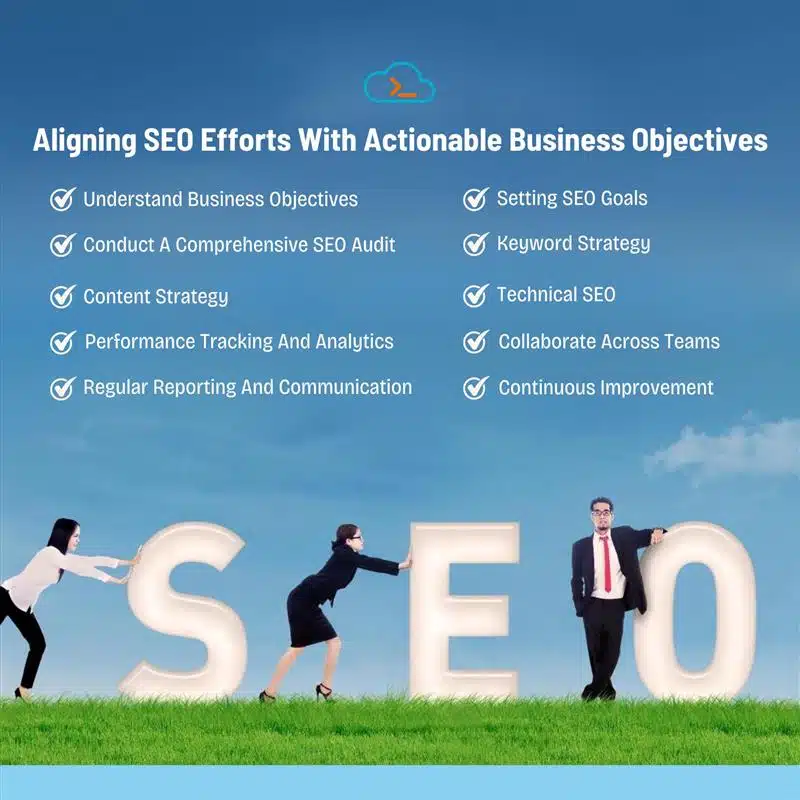Search engine optimization SEO is a powerful tool used by professionals to improve websites, pages, and content visibility in search engines like Google. SEO involves a range of practices focused on enhancing the appearance, positioning, and usability of various types of content in organic search and search engine results pages.
This article encompasses web pages, video media, images, local business listings, and other assets. Given that organic search is the primary means through which people discover online content, applying search engine optimization best practices is indispensable for ensuring that the digital content published can be easily found and selected by the public from the search engine result pages and landing pages. ultimately boosting your website’s organic traffic.
Key Takeaways
- Using targeted keywords that align with business goals is crucial, driving significant business results such as sales and engagement.
- Integrating SEO into business and marketing goals creates a cohesive online presence.
- Collaboration between SEO and content teams is essential coordinating strategies, aligning content calendars, and streamlining content.
Key Metrics To Set SEO Objectives
The factors below help set up SEO goals or SEO campaigns.
- Customer lifetime value
- Return on investment (ROI)
- Google business profile metrics
- Organics visibility
- Cost per acquisition
- Keyword ranking higher or lower
- Conversions based on sales and leads
- User engagement metrics
- Backlinks
- Branded vs. non-branded traffic
- Organic sessions
Best Practices For SEO Goals and Strategies
SEO (Search Engine Optimization) encompasses various strategies to augment a website’s visibility on search engines and its search engine results pages (SERPs). Here are some best practices:
1. Keyword research and usage
Make sure first to identify the keywords that your target audience is actively searching for. Utilize these target keywords more naturally in titles, headings, and content while avoiding keyword stuffing.
2. High-quality content
Craft meaningful, informative, and captivating content that resonates with your audience’s interests. Incorporate a blend of text, images, videos, and infographics to enrich the user experience with the assistance of enterprise SEO agencies.
3. On-page optimization
Make sure that each page has a unique and descriptive title tag that contains relevant keywords and reflects the page’s content. Additionally, craft compelling meta descriptions that effectively summarize the page content and incorporate relevant keywords. When creating content, use header tags (H1, H2, H3, etc.) to structure the information and emphasize key points logically.
4. Technical SEO
Optimize your website to be responsive and perform well on mobile devices. Improve site loading times by optimizing images, using browser caching, and minimizing code. Ensure site security by using HTTPS.
5. User experience
Make navigation intuitive and user-friendly. Reduce bounce rates by providing clear calls to action and easy-to-find information.
6. Internal and external linking
Use internal links to effectively direct users to relevant content within your site. Additionally, high-quality backlinks from authoritative and reputable sources should be sought to increase conversions, drive organic traffic, and strengthen authority.
7. Local SEO
To improve your online presence and attract local users searching for keywords. It’s essential to optimize your website for local search, particularly if you have a physical location. Also, ensure that your business is listed in relevant local directories and on Google My Business.
8. Regular updates and audits
It’s crucial to keep your content fresh and conduct regular technical audits to maintain a high-performing website. Leverage tools like Search Console and Google Analytics to monitor your site’s performance and make informed, targeted traffic data-driven improvements.
9. Schema markup
Don’t forget to incorporate structured data to assist search engines in understanding your content and optimizing SERP features like rich snippets.
10. Social media integration
Promote content through social media to increase brand visibility and drive traffic to your site.
Following these best practices helps ensure the website is optimized for search engines, improving chances of ranking higher in search engines, more traffic, and attracting more quality traffic.

Aligning SEO Efforts With Actionable Business Objectives
Aligning SEO goals with the business strategy and objectives involves integrating SEO strategies into the overall business plan to ensure that SEO efforts drive growth, generate leads, increase organic traffic, and support the company’s aims.
Here’s a detailed approach to achieve this alignment:
1. Understand business objectives
Understanding the company’s short-term and long-term goals is the primary objective of setting SEO goals. These include increasing revenue, expanding market reach, improving customer satisfaction, or launching new products. Determine the key performance indicators (KPIs) that measure success for these objectives, such as revenue growth, customer acquisition, conversion rates, or brand awareness.
2. Setting seo goals
Convert business goals into specific SEO targets. Ensure SEO goals are specific, measurable, achievable, relevant, and time-bound: SMART.
3. Conduct a comprehensive SEO audit
Review current SEO performance with help from SEO companies to identify strengths, opportunities, weaknesses, and threats. Compare against competitors to understand the market landscape.
4. Keyword strategy
Identify keywords relevant to the business’s products, services, and target audience. Focus on the long tail keywords that hold high search volume and align keyword research with business priorities. Ensure certain keywords are a mix of long-tail and short-tail keywords.
5. Content Strategy
Develop a content marketing strategy that discusses the target audience’s needs and interests while also aligning with business goals. Build a full content creation and content calendar that aligns content creation with marketing campaigns, product launches, and other business activities.
6. Technical SEO
Ensure the website is technically sound, with fast load times, mobile optimization, secure connections (HTTPS), and proper indexing. Regularly audit and fix technical issues that could hinder the quality of traffic or SEO performance.
7. Performance tracking and analytics
Tools like Google Analytics, Google Search Console, and other SEO tools help to track these key performance indicators. Track SEO metrics (organic traffic, bounce rate, keyword rankings) alongside business metrics (sales, leads, revenue).
8. Collaborate across teams
Work with marketing, sales, product development, and other teams to ensure SEO strategies support overall business activities. Ensure all teams understand the role of SEO in achieving overall business strategy and objectives and contribute to its success.
9. Regular reporting and communication
Provide regular reports showing how SEO and online marketing efforts contribute to business goals. Demonstrate the impact of SEO and online marketing efforts on business goals using data and insights.
10. Continuous improvement
Keep up with search engine algorithm advancements and industry best practices. Continuously refine SEO strategies based on performance data, market changes, competitor analysis, and business needs.
Conclusion
For the success of a digital content marketing and content strategy, it is essential to align the business goals with SEO goals. This alignment facilitates a cohesive approach toward a shared vision. The relationship between SEO and content marketing has become increasingly intertwined. Creating high-quality content enhances your search engine ranking, while effective SEO strategies amplify the reach of your content.
By integrating these steps and other content marketing strategies with the assistance of the best enterprise SEO services in India, businesses can ensure their paid advertising and SEO efforts are effectively contributing to their broader objectives, resulting in a cohesive and impactful digital strategy.
Frequently Asked Questions
How do I create an SEO strategy for my business?
First, find a keyword, check your website, and analyze your competitors. Then, create something new and better. Finally, optimize SEO on web pages and align with search intent.
What are the top 5 SEO strategies?
Check out the free SEO Check Tool at SEO.org today! Ensure easy website access, use targeted keywords, enhance your local listing, create high-quality content, update old content, assess ROIs, improve search engine rankings, and increase lead conversions.
What are the strategic goals of SEO?
SEO Benchmarking, Seasonality, Increase organic sales to X%, Boost website backlinks by X%, Improve page speed, Diversify websites, Reduce bounce rates, Increase daily time on site by X%.

